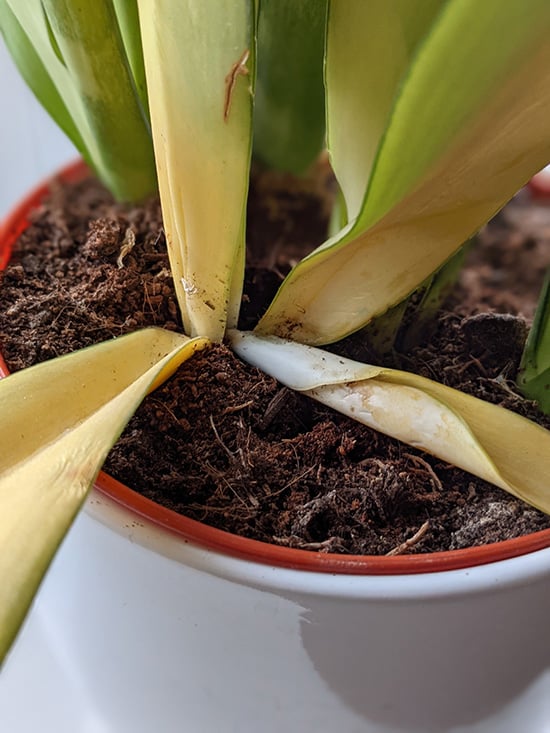How Snake Plant Leaves Turning Yellow can Save You Time, Stress, and Money.
Wiki Article
The Facts About Snake Plant Leaves Turning Yellow Uncovered
Table of ContentsThe Ultimate Guide To Snake Plant Leaves Turning YellowFascination About Snake Plant Leaves Turning YellowSnake Plant Leaves Turning Yellow for DummiesThe 30-Second Trick For Snake Plant Leaves Turning YellowSnake Plant Leaves Turning Yellow Can Be Fun For Everyone
Right here are seven reasons your serpent plant's leaves could be turning yellow and how to fix it. A number of various plant troubles can cause yellow fallen leaves, or chlorosis. Chlorosis occurs when plants don't have the trace elements they require to produce chlorophyll, that makes vegetation environment-friendly and allows plants to convert sunshine right into food.Serpent plants are dry spell forgiving thanks to their succulent fallen leaves. Snake Plant Leaves Turning Yellow. These plants expand finest in loose, well-drained soil that's allowed to dry completely in between waterings and may only require water as soon as monthly throughout winter months. Overwatering can stop roots from soaking up wetness and nutrients that the plant requires and can even cause root rot
A potbound plant can't take in nutrients from the dirt. If your serpent plant is jammed or outgrowing its pot, this might be the source of yellow fallen leaves. A periodic yellow fallen leave is completely typical for a serpent plant. As the plant ages, old leaves yellow, die, and hand over as they're changed with brand-new ones.
Ensure the plant has intense, indirect light and continually cozy temperature levels, and water just when the dirt has actually completely dried out. Watch out for troubles and capture them beforehand to keep your plant looking healthy and lovely.
The Ultimate Guide To Snake Plant Leaves Turning Yellow
If the leaves on your serpent plant are obtaining soft, it's usually a sign of way too much water. Serpent plants store water in their fallen leaves and if they're overwatered, the fallen leaves can become soft and mushy. If you assume your snake plant is being overwatered, allow the soil to dry out entirely prior to sprinkling once more.Yes, some yellowing is regular and to be anticipated on older leaves, particularly as snake plants age. If the plant is or else healthy and balanced and the leaves are only gently yellowed then there is no reason for issue. If the leaves are dramatically yellowed or if there are various other indications of distress then it's finest to take action.

In general, serpent plants should be sprinkled every one to two check out this site weeks. If you believe your serpent plant has been overwatered, the initial step is to quit sprinkling it.
Snake Plant Leaves Turning Yellow for Dummies

The snake plant is an awesome houseplant. The serpent plant is just one of those plants that are great for growing inside your home in a terrarium, Snake plants can grow fairly big, but they likewise have a tendency to be pretty low-maintenance. That does not indicate you shouldn't take notice of their look. Expect your near the bottom due to a lack of nutrients or various other troubles.
When the soil is overwatered, the plant cells absorb more water than they can save. Read here to Leaves ended up being soggy and yellow as they soak up extra water. Drooping snake plant fallen leaves are triggered by soaked-up leaf cells losing their firmness. You might discover that your snake plant will certainly come to be black or brownish if the yellow patches are not corrected by fixing overwatering.
It is, for that reason, much more likely that your plant will identify yellow spots on its leaves if you overfeed it with plant food during winter. The leaves of snake plants are also at risk to yellowing when overfed, especially if the roots are delicate. Repotting your yellowing, watering just when the dirt dries, and supplying optimal temperature and light conditions can wait.
How Snake Plant Leaves Turning Yellow can Save You Time, Stress, and Money.
To stop yellowing created by overwatering, stop get more watering the serpent plant up until the dirt entirely dries out. Water your serpent plant only when the top two inches of soil really feel dry.Your can be removed by removing the yellow go suggestions - Snake Plant Leaves Turning Yellow. The pruned fallen leaves should grow longer if they are sprinkled properly and have ideal light and temperature conditions. It is necessary to bear in mind that the sharp suggestions will certainly not grow back, triggering them to stick out from the remainder of the leaves
It will not take long for the fallen leaves to grow back and expand like the healthy and balanced fallen leaves around them. Alternately, you can get rid of afflicted fallen leaves from the base of the plant. The indicates that it's getting excessive or insufficient light or nutrients. The vital message is to permit the snake plant time to recover.
Scroll the short article till the end to locate the service. Pay attention to this write-up right here: The circumstance can be expected if you have had your snake plant for a very long time, and yellowing takes place on the reduced leaves as an all-natural aging cycle. It is typical for the Sansevieria leaves to transform yellow due to newbie errors and when the plant is just gotten from the baby room for repotting.
Snake Plant Leaves Turning Yellow Fundamentals Explained
A few of the most common causes are listed below. Sansevierias like completely dry climates and favor little water maintained at a void of one or two times regular in summer and regular monthly in winter months. When the water dose gets out of control, your Sansevieria will certainly experience from overwatering. The most typical issue issued by overwatering is root rot resulting in mushy origins and stems with a nasty scent.Report this wiki page